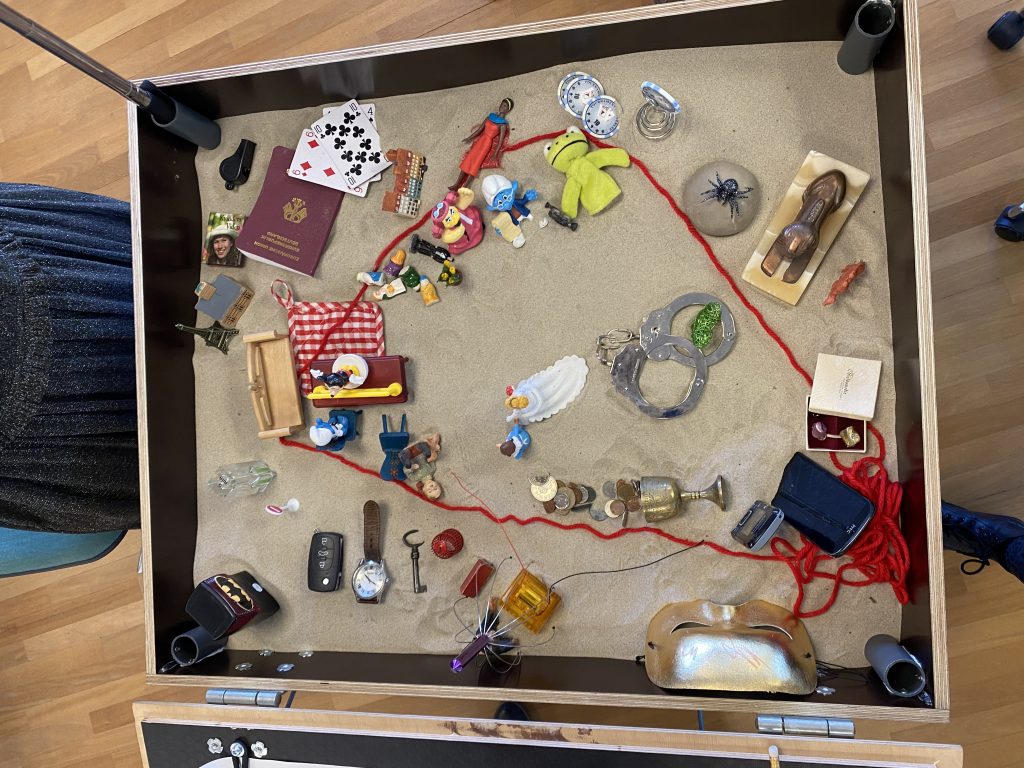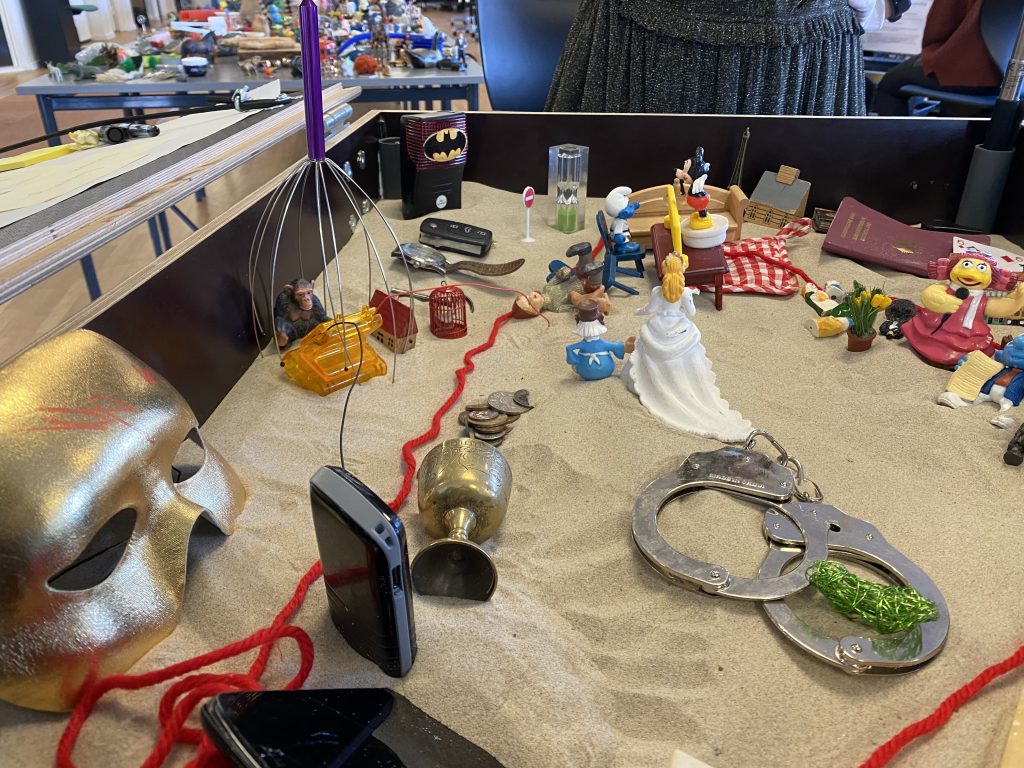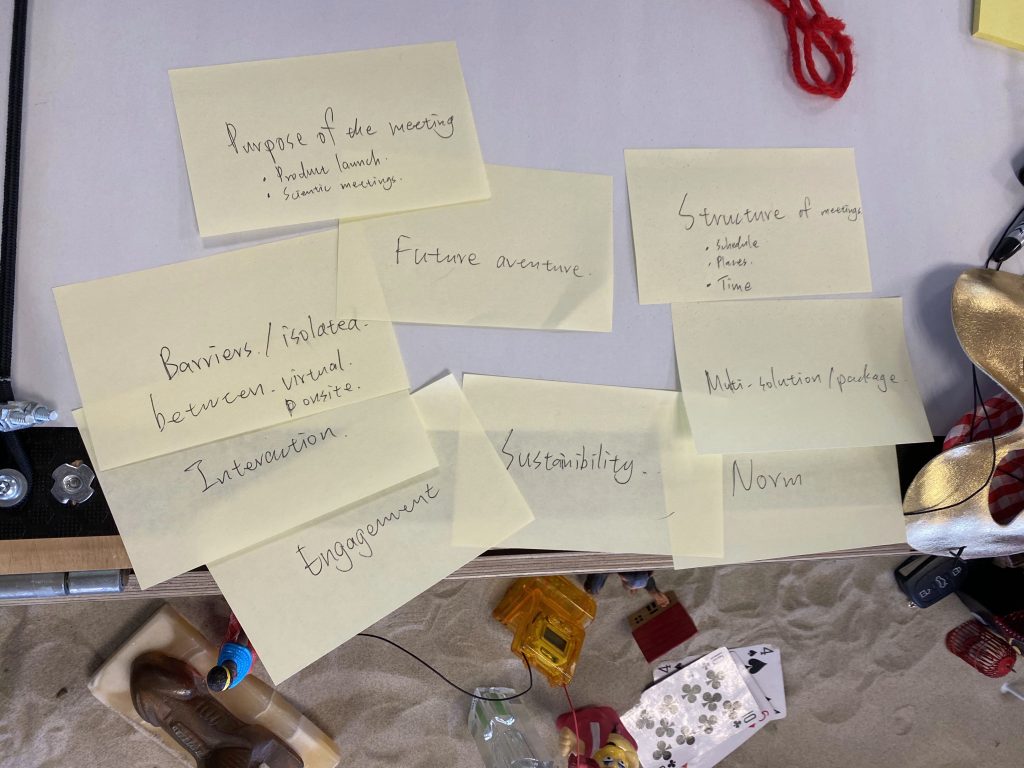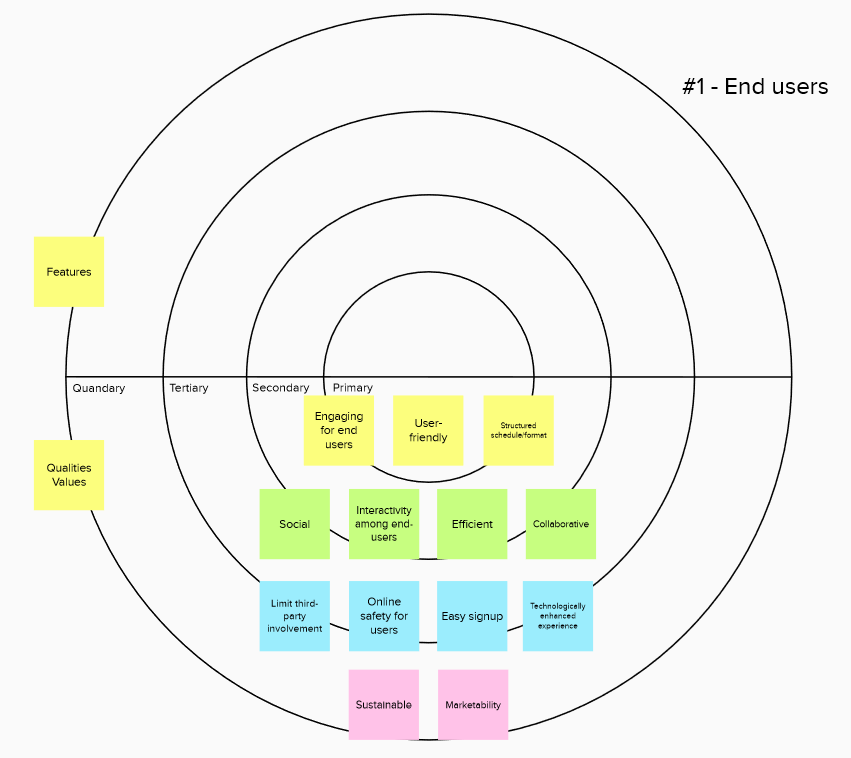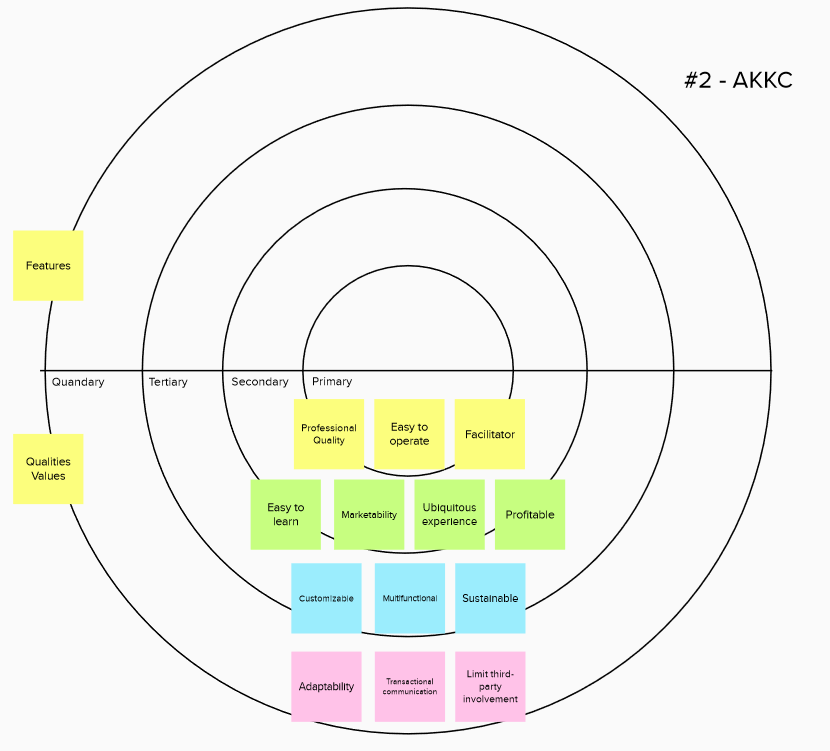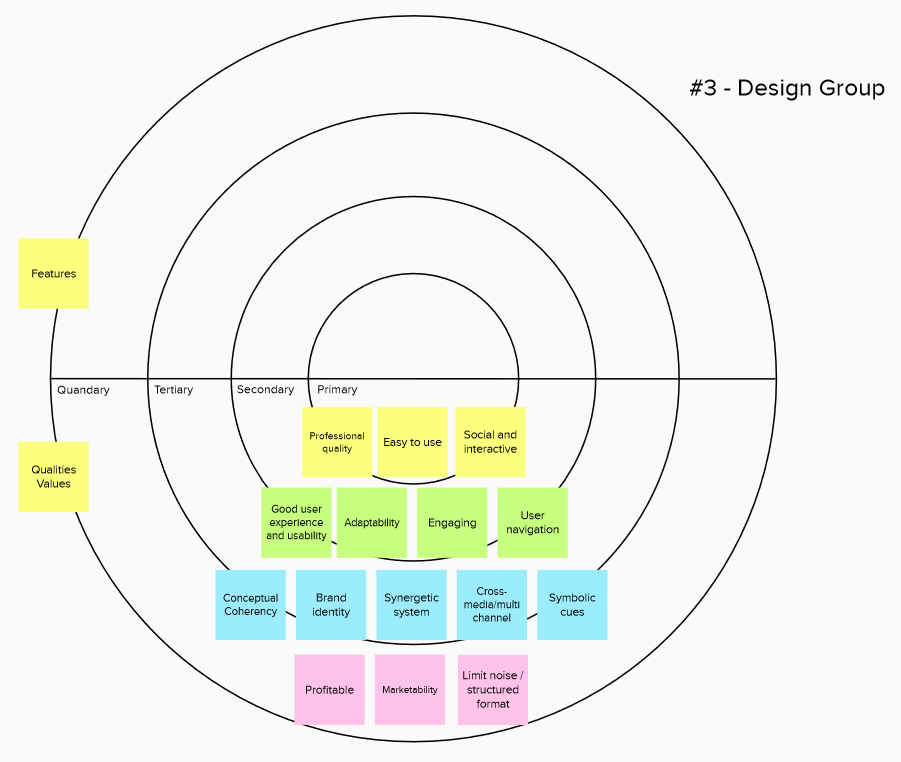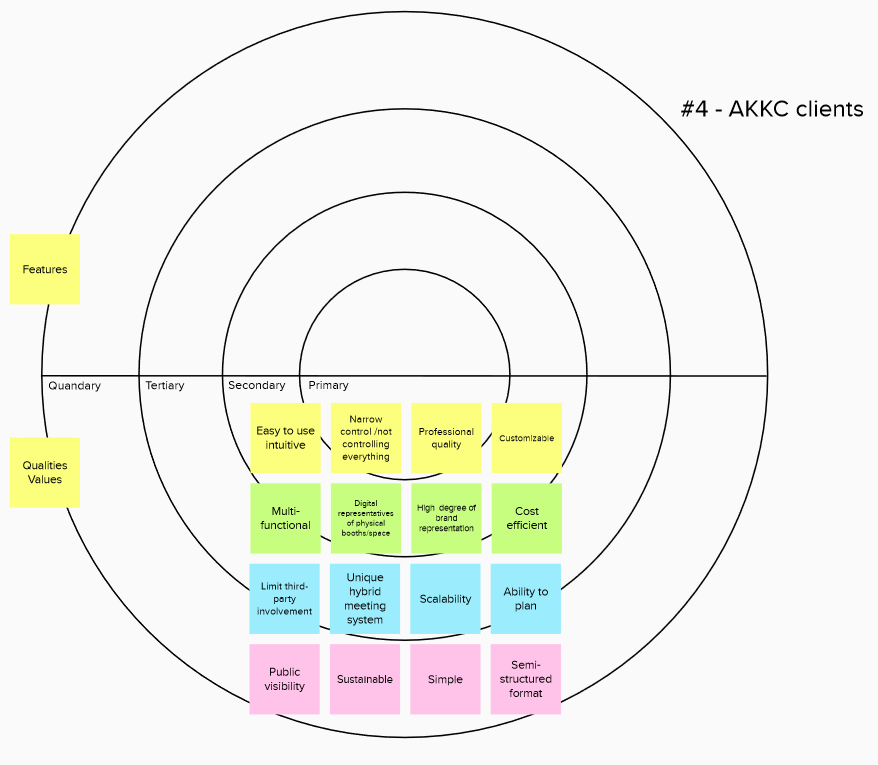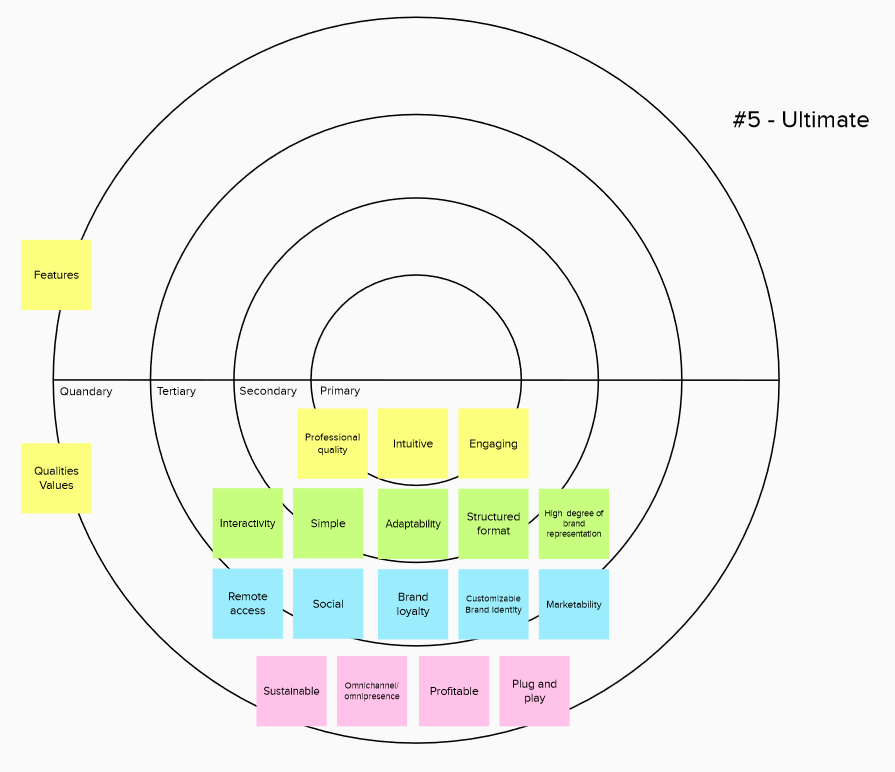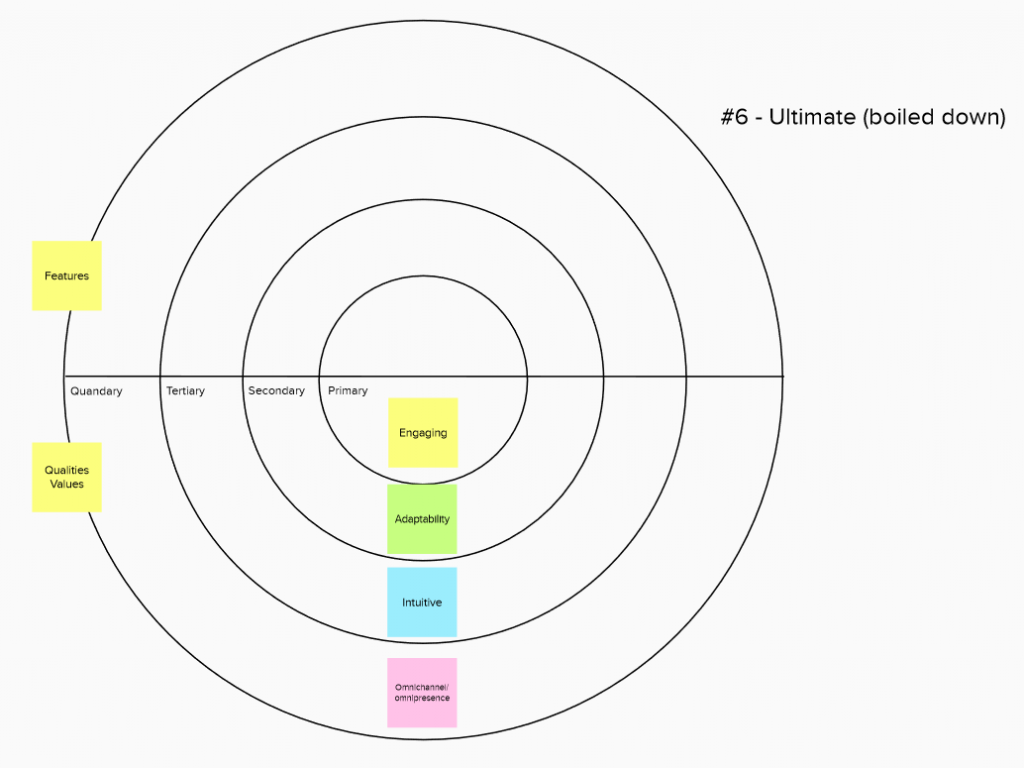AKKC has had to change much of their daily routine and operations with COVID-19 restrictions strictly limiting the capacity of their meeting rooms and convention halls. In an attempt to fix this, the team at AKKC wants to adopt so-called hybrid meetings as standard practice, where both physical and virtual guests can attend conventions, conferences and meetings. The only question is how one might make that system without heavily favoring one side of the solution over the other.
Members of the team:
Daniel Deleuran
Louise Romme Pedersen
Benedikte Henny Grundahl Holst
Gustav Schrøder
Xiao-Yin Xu
Concept video
This is the hand-in for the deliverable: 1 final video scenario.
After one week of heavy data collection and correspondence with the team at AKKC, and another week of brainstorming and problem-solving, we settled on a solution for holding hybrid meetings that can work out for everyone. This is done by allowing virtual guests to navigate active conferences through a virtual 3D space by clicking into live camera feeds to watch and interact with speeches as well as meeting points for networking opportunities that cross between the virtual and real world.
The Design Process
Day 1
Meet and greet between group members, learning about each other’s professional and personal competencies.
Creation of introductory group video uploaded in Teams -> General.
Day 2
Plan for empirical work
Tuesday the 27th October
- One group interviews family members and friends that have experience with digital meetings in regard to their jobs.
- Louise interviews her mother [TBD]
- Daniel interviews his parents [Tuesday & Wednesday]
- Benedikte interviews her sister [TBD]
- Gustav interviews his boss [Wednesday]
- Xiao-Yin interviews her friend [Tuesday]
Semi-structured interview format
- Loose guiding questions to guide the interview, with the possibility to expand on certain areas of discussion:
- What is your job?
- Have you had to make use of digital and online meetings?
- Was it a good or bad experience?
- What made the experience good/bad? Why is the experience good/bad?
- Was it a good or bad experience?
- What, in your opinion, is the key difference between physical and online meetings?
- What is gained by holding digital meetings and what is lost from the physical format?
- What is gained by holding physical meetings and what is lost from the online format?
- Do you have any experience with hybrid meetings?
- Was it a good or bad experience?
- What made the experience good/bad? Why is the experience good/bad?
- What technologies are used?
- Was it a good or bad experience?
- What is a successful meeting for you?
- What do you hope to gain from a meeting?
Wednesday the 28th October
- Visit AKKC with a guided tour from two members of the management
- Daniel & Gustav will be attending the tour at AKKC
- Daniel will be taking on the role of conducting photographic and video documentation of the space
- Gustav will be taking notes of the most noteworthy information we learn from the management on the tour
- We will make use of this tour to ask for possible information regarding an example or two of companies that have rented meeting halls and what they used them for (further info like what type of company, were guests invited or entry cost, etc.)
- If not, ask for potential contact with a client business.
Possible Data Collection [Not Confirmed]
- Gustav sitting in on a meeting with his boss – walk-along, shadowing [Monday the 2nd November]
Day 3
Gustav & Daniel attended a guided tour at AKKC, held by two members of management. Daniel was responsible for photographic and video documentation of the space and the current situation in almost every meeting room and hall. Gustav was responsible for diligent note-taking, as our guides provided us with much information relevant to our project.
More members did not attend the guided tour due to Covid-19 restrictions.
Benedikte, Louise & Xiao-Yin did not attend the guided tour, instead conducting desk research regarding the topic of hybrid meetings and finding possible inspiration and a new perspective from existing solutions, whether that be the advantages, disadvantages of such a format or potential challenges our group might face in the near future.
Throughout the day, multiple members held online and face-to-face interviews with candidates considered to be typical end-users of such a hybrid meeting system, as well as the more standard online meeting format.
Day 4
Material Storytelling
At the start of the day, we had an online lecture on Affinity Diagramming as well as Material Storytelling as methods for interpreting and exploring the data we collected on the previous days.
Out of the two methods, we chose to go with Material Storytelling, as none of us had any real previous experience with using the method – which means we really wanted to try this cool new method out!
Basically, our use of Material Storytelling went as follows:
We all met up at the Material Storytelling Lab at the Create building down by the Aalborg harbor save for one of our groupmembers, who unfortunately fell a bit ill. Never the less, we proceeded with the Material Storytelling session:
Each group was assigned a sandbox in which we could organize figures in settings that we would then interpret and relate to our case, the possibility of hybrid meetings through the AKKC. Each groupmember picked out an object (or several) and proceeded to configure some sort of setting in the sandbox, as seen in the picture below:
Image 1: Our Material Storytelling Sandbox, first configuration
The first configuration can be seen in the image above. From this point onwards, we each tried describing what we saw – and how it might relate to the case. For an example, we had this monkey in a cage on the left side of the image below:
Image 2: The monkey in the cage (on the left side of the sandbox)
If the red thread outlined and represented a conference room at the AKKC, with all of its participants, then the monkey in the cage signified the users at home – the ones participating online. The “cage” around the monkey would then signify how we believe that users at home could easily feel isolated if not properly introduced to and continuously invited to participate in the meeting at the AKKC in a hybrid setting. So, we decided that a key element in our concept should include an element of some sort that actively engages the attention of the people at home as to avoid a situation that the AKKC experienced with a recent hybrid meeting, the sustainability festival: a lot of people would tune into the hybrid meeting, but would then quickly leave again for some reason. Could it be that they felt isolated, or perhaps that there was something more interesting available to them on their device? The monkey-figure would then also signify the simplicity we all experience when we use devices for work situations that also afford entertainment options – perhaps the monkey doesn’t want to watch some boring meeting if it’s way more engaging to go on Facebook.
As to not make this resume too long, at the end of the Material Storytelling session, we compiled a bunch of different themes that we thought to be integral to our concept which we will be developing going forward, as seen in the image below:
Image 3: Key elements of our concept to be
The key elements we ended up agreeing on as the result of our dialogue based on the sandbox configurations are as follows:
- #1 Barriers/isolated between virtual participants
- If we want the users to avoid feeling isolated (like monkeys in a cage), our concept should allow for interaction between digital and real-life participants, and between the two groups internally as well.
- That brings the question: what kind of interaction, using what kind of platform, in order to achieve what goal?
#2 Engagement
- If the mediated content isn’t made engaging for the ‘people at home’, they will ‘change channels’ to something more interesting just like the AKKC experienced with the Sustainability Festival.
- We disussed the possibility of ‘Facilitators’ at the venue, who make sure that the people at home has a representative, a cameraman and someone who can engage them and keep them interested in the meeting as it transpires.
#3 Interaction
- Our concept has to address the possible ways for digital and physical participants to interact with one-another as well as with the mediated content of, for an example, a presentation – eg. how do people online ask a question, or network with people at the venue?
#4 Purpose of a meeting
- Product Launch/Informing participants
- Networking/Getting to know your employees or coworkers
- The ‘succes’ of a meeting depends on the purpose
#5 Future Adventure
- One of our groupmembers proposed the idea that this new hybrid meeting format shouldn’t just be an option during the corona pandemic, but should instead become an adventurous endeavor to create a longer lasting format that will shape the way we hold meetings and conferences into the future.
#6 Structure of meetings
- We need to get a concrete idea of the schedule, places and timetables of a meeting/conference if we want to propose a realistic concept for hybrid meetings, perhaps with inspiration from the Sustainability Festival, for which these elements can still be found on the AKKC website.
#7 Multifunctional package
- The group had a dialogue about whether or not we should focus on a specific part of the conference/a meeting, or if we could propose a concept which, essentially, is a multifunctional package that supports the different aspects of a meeting/conference (presentation, networking, etc.) which a company could be interested in opting into or out of when they contact the AKKC in order to hire them for a conference.
- The ‘multifunctional package’ for a hybrid meeting could include:
- A hybrid presentation with an engaging live-stream
- A platform with forums, chatrooms and direct messaging options akin to Facebook Messenger or Workplace.
- A digital display in which the people at a workshop or networking event can see and speak with the people participating from home, with a facilitator at the venue to ‘smooth the experience and keep it engaging’.
#8 Sustainability
- Sustainability is a keyword for the AKKC – and hybrid meetings should be marketed as the sustainable option, as companies save big time both on transport and consumption of physical goods (food, paper, etc.) at the venue.
#9 Norm
- The group had a dialogue about the fact that people might not be used to the norms of digital meetings – for an example the fact that breathing into your microphone sounds terrible for others. Our concept should address the issue of how to establish norms for the hybrid/digital part of the meeting/conference.
Day 5
Core Design Deliverable
At the start of this day, a lecture regarding Core Design was presented wherein our findings from the last several days would be distilled toward certain qualities we might want to address moving forward. We began with four models, aimed towards understanding different stakeholders’ perspectives on a potential solution. This includes from the perspective of the end-users, of AKKC itself, of businesses looking to hold a meeting at AKKC and from our own perspective as a design group.
We used these four models to better gain an overview of what qualities in a potential solution would be most important overall and to the benefit of everyone. We called this the ultimate version of the model and further distilled that version towards one with only one quality in each priority ring. This is the version we intend to present to our case-partners today and possible reiterations of the model will occur with any new information and insights provided by AKKC.
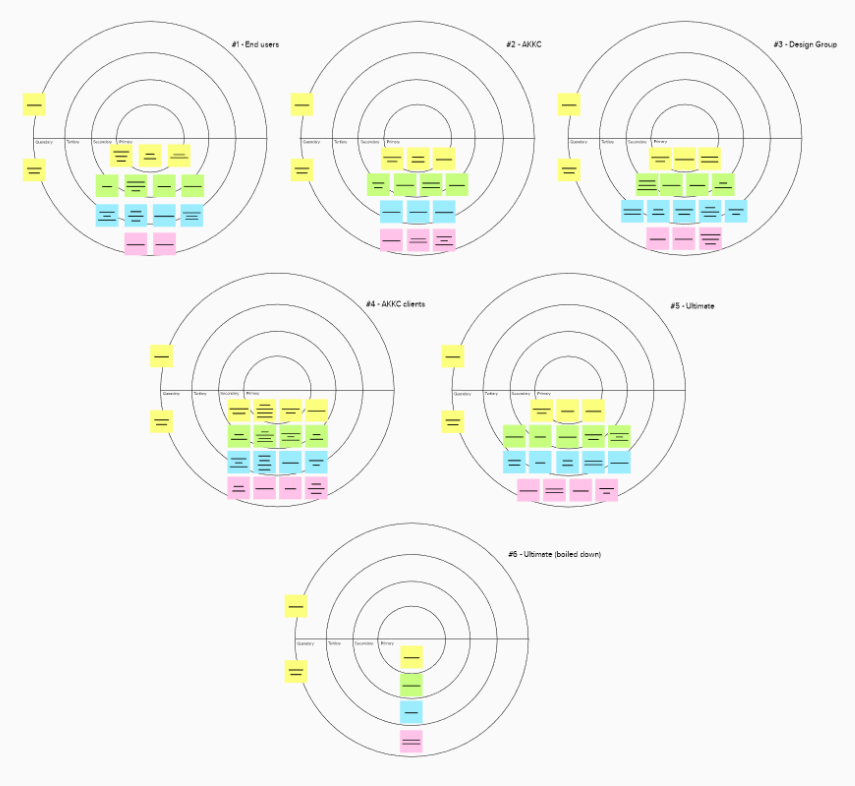
This overall view of our models shows our process of funneling our insights from data collection into one “ultimate” version.
The first model considered the perspective of the end users, actually interacting and viewing hybrid meetings. What are the qualities that they would prioritize in any potential solution?
Our insights into end users comes from conducting several interviews with people experienced in using online meetings and with somewhat less experience with hybrid meetings as well. Most interviewees indicated a need for an either totally or semi structured format with online meetings as conversation does not flow as naturally as in real life and therefore some rules and moderation are needed to create a successful meeting environment. Other than that, interviewees emphasized having meetings held on easy-to-use platforms so that sign-up and general use are quick and easy.
Our second model was based on AKKC’s own wants and needs in regards to qualities for a potential solution. These are based on our meetings with the case-partner and our own insights from our guided tour at AKKC with management. The main insights here are in regard to quality of solution and also towards creating an online version of the meeting that is equal to the physical representation – thereby not having an A or B team. Another key aspect of a solution for AKKC is in having an easy-to-use and adaptable solution that can be applied toward all the different functions and meeting rooms available.
The third model is based on our own insights as a design group, with perspectives from many different academic and professional competencies: our own recommendation for prioritizing qualities for a potential solution.
The fourth and final version of the model based on stakeholder perspectives is based on qualities wanted by the businesses that rent out rooms and halls at AKKC. These insights include having an easy to use and intuitive platform to use, having some degree of control over the platform to tailor it for their own use as well as having a professional quality stream to represent their own brand properly.
Finally, when these qualities were distilled into an ultimate version of the model, what we came to was to prioritize a professional level of quality, with an intuitive design for use and an engaging level of interactivity for end users on the platform.
We boiled this model down to a much more streamlined version to better address these qualities with functions next week in our problem-solving and solution-creating phase.
Now we’ve had our meeting with the case partner and they had nothing to add other than aggressive nodding and that we are working in a great direction. Good news!
Day 6
On the sixth day, we entered the solution phase of the Design Sprint Workshop – taking us from the quality criteria of day 5 into an ideation process wherein we might discover ideas on how create a solution for the problem(s) the case partner, AKKC, are facing with hybrid meetings.
The program of the day was as follows:
- “Re-cap decisions from your case partner meeting & write summary for the website
- Transform your quality criteria into a HMW (How Might We) question
- Generate 8 ideas on the basis of your HMW question before evaluating and selecting the 5 best ideas
- Improve and refine the 5 ideas with 8 complimenting ideas
- Evaluate all your ideas against your HMW question – select / combine into 3″ – ucrac
As we had already uploaded a summary of the meeting, we dove head-first into transforming our quality criteria into a ‘How Might We’ question. Each groupmember proposed 3 HMW questions in our shared document, after which we collectively went through each and selected / combined our questions into our ultimate HMW question:
How might we – through an adaptable and professional platform – facilitate that virtual participants in a hybrid meeting, no matter the medium, retain physical and genuine, involved presence and equal opportunity for interaction with both content and other participants without prioritising one group over the other?
With this HMW question as the base, we continued the ideation process by generating 8 ideas which could solve parts of – if not the entirety – of the question. From these 8 original ideas, we selected / combined them into the following 5 ideas:
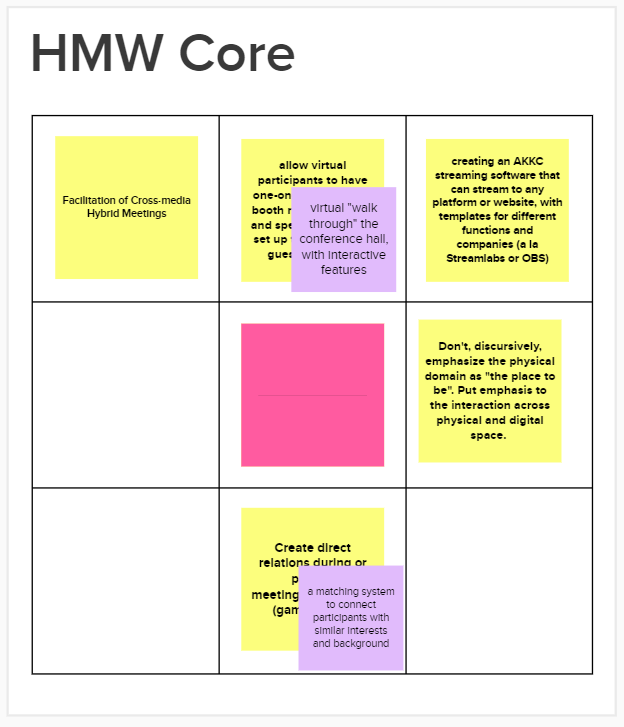
These five ideas of how to solve the ‘How Might We’ question were then divided into each of their own 3×3 matrixes, where we then proposed an additional 8 complimentary ideas to each of the original 5. In the following paragrafs, I will briefly go through each of the 5 idea matrix that we worked on as well as provide examples of what those ideas entail:
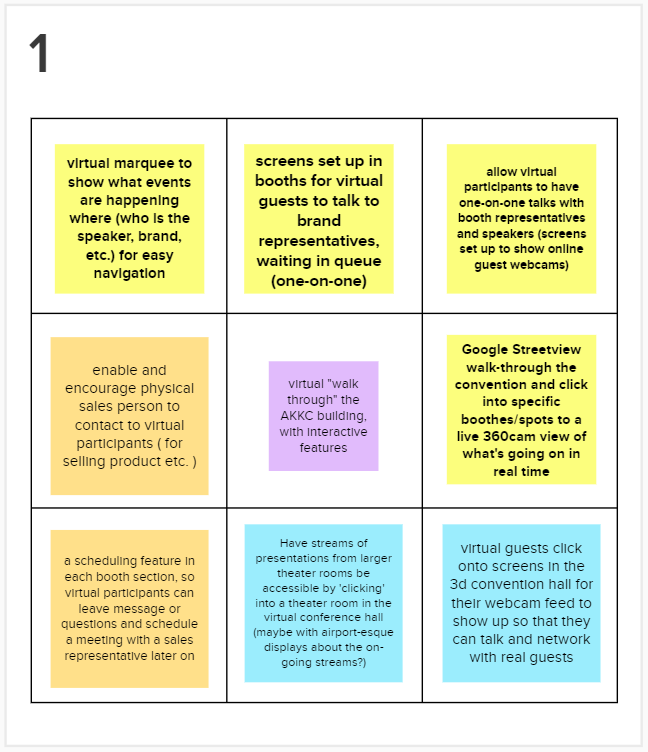
In idea matrix #1, we focused on the idea of creating a virtual ‘walk through’ of the AKKC building with interactive features, in which the virtual participants could both navigate and interact with elements such as a camera or a stall in order to access content in the respective area of the real-life conference area – fx by allowing virtual participants to “have one-on-one talks with booth representatives and speakers” through screens which show online guests through the use of their webcamera and microphone.
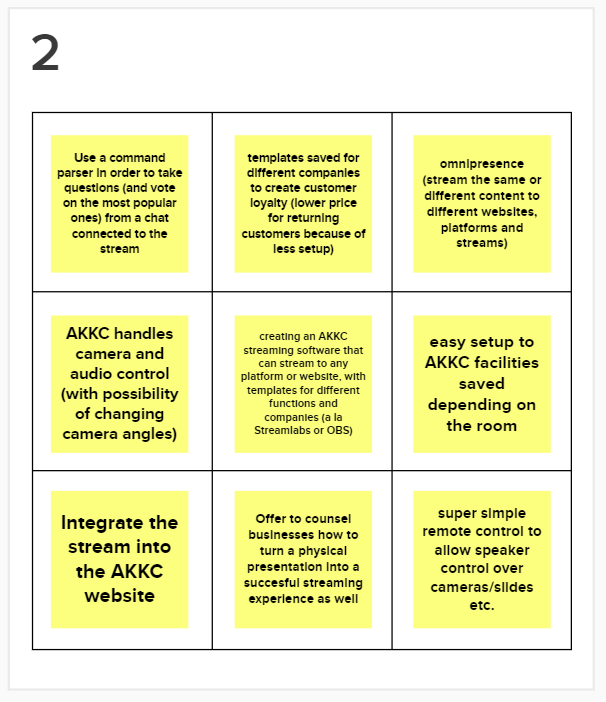
In idea matrix #2, we focused on the possibility of tailoring a streaming service to AKKC which for an example allows for both “easy setup to AKKC facilities” as well as integration into the existing AKKC website.
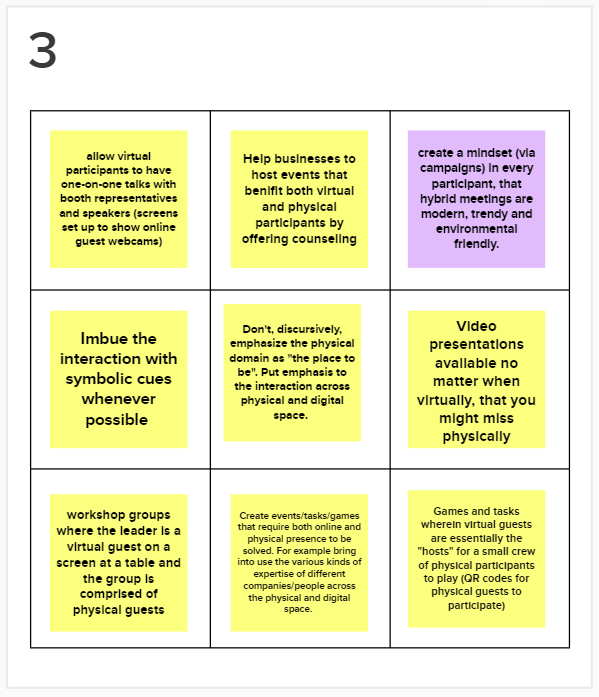
In idea matrix #3, we focused on putting “emphasis to the interaction across physical and digital space”, for an example by creating templates for events or workshops that require virtual and physical participants to interact with one another.
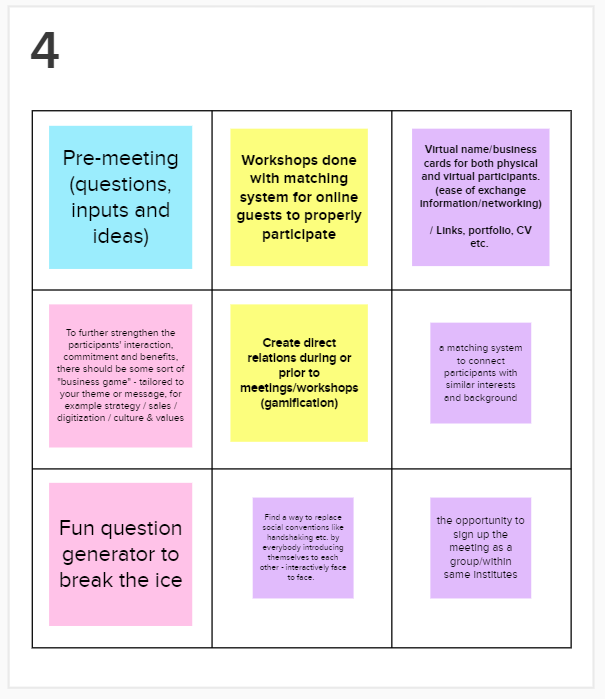
In idea matrix #4, we focused on the idea of building relations between participants both prior to and during a meeting or conference, fx by introducing a match-up system that connects participants based on similar interests and backgrounds.
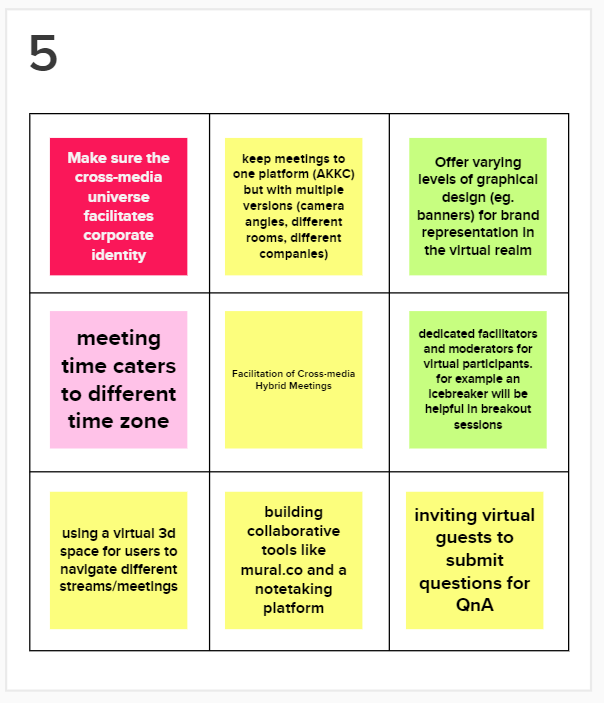
In idea matrix #5, we focused on the idea of facilitating cross-media hybrid meetings, fx by using a virtual 3D space to ease virtual user navigation, fx by clicking away from a stream of a presentation in the larger theater at AKKC to a smaller sideroom for networking purposes.
Finally, we compared each of our ideas to our original HMW question – how well do they solve it? In the end, we decided to combine some of our ideas into the 3 main ideas with which we intend to continue our conceptual design process:
Idea #1 – a virtual 3D space of the AKKC building to navigate containing a variety of content, fx:
-
- Interactive camera feeds
- Contact points, eg.:
- virtual guests click onto screens in the 3d convention hall for their webcam feed to show up so that they can talk and network with real guests
- allow virtual participants to have one-on-one talks with booth representatives and speakers (screens set up to show online guest webcams)
Idea #2 – Games and workshops wherein virtual guests are essentially the “hosts” for a small group of physical participants to play (QR codes for physical guests to participate)
-
- Tables or standing areas set up around screens where online guest webcams are shown and physical participants follow instructions and work together according to the virtual guest on the screen
- Virtual guest, acting as host, is given rules and format through the platform
Idea #3 – A matching system to connect participants with similar interests and/or background
-
- Can be signed up through organisation and grouped with colleagues
- Pre-match quiz to establish your interests and professional background
- Business card info can be filled out to allow for easier networking (links, LinkedIn, portfolio, CV etc)
That’s about it for day 6. Stay tuned for day 7!
Day 7
Tuesday the 3rd November
Day 7 was spent entirely on planning our video sketching for the next day. We split off with individual tasks of storyboarding one video each, which we could use as a baseline or a springboard into our work on the next day.
Day 8
Wednesday the 4th November
Today was the day for finally visualizing our concepts into videos. We reconvened in the CREATE building with our individual storyboard assignments, so that we could review our ideas and discuss any inconsistencies with our previous ideation.
We set off to convert our storyboards into individual video sketches using stop motion paper cutouts, available below.
Sketches of the concept
Video Sketch #1
This first video sketch visualizes the idea of involving virtual guests in a hybrid meeting more within the context of workshops and game activities held by organizers. Virtual guests would volunteer to be hosts and leaders for groups of physical guests collaborating during workshop activities, with the virtual hosts being able to present the group’s work up on stage at the end.
Video Sketch #2
Video sketch number 2 involves the idea of matching virtual and physical guests through a short survey, to allow for networking across the divide of hybrid meetings.
Video Sketch #3
The third video sketch discusses the more general platform for virtual guests to navigate and interact with conventions and conferences at AKKC through a virtual 3D space, including possible interactions with actual keynote speeches and events through multiple camera angles and live feeds.
Video Sketch #4
In this video sketch, we visualized the idea of physical guests being able to navigate towards meeting points set up in conference halls where a screen and a webcam are available for virtual guests to access and network with random guests on the convention floor.
Video Sketch #5
This video discusses how booths at conventions could be interacted with and formatted more strictly to allow for both virtual and physical guests to have one-on-one interactions with brand representatives for networking opportunities and business discussions, much like at a pre-Corona convention.


